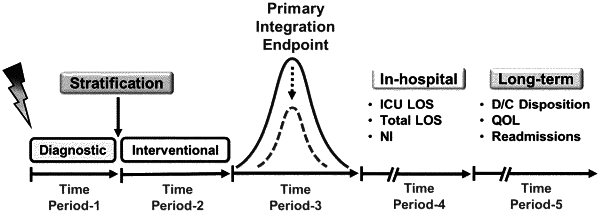| CPC G16H 50/30 (2018.01) [G16B 20/20 (2019.02); G16B 40/00 (2019.02); G16B 40/30 (2019.02); G16H 20/10 (2018.01); G16H 50/20 (2018.01); G16H 50/70 (2018.01); G16H 70/40 (2018.01)] | 20 Claims |

|
1. A computer-implemented method of determining risk of developing multiple organ dysfunction (MOD) in a trauma patient, comprising:
generating, with a processor, a dataset of stored values comprising an aMODD2-D5 value for a statistically-significant number of patients and a diagnosis of a nosocomial infection, the aMODD2-D5 value comprising a MOD score, obtained on days 2-5 following a trauma injury based on a machine learning model trained with a regression analysis, the regression analysis applied to a panel of biomarkers, the panel of biomarkers comprising one or more of interleukin 6, interleukin 8/CCL8, interleukin 10, IFN-γ inducible protein (IP)-10, plasma levels of soluble ST2, monokine induced by gamma interferon, monocyte chemotactic protein (MCP)-1, chloride, CO2, creatinine, partial thromboplastin time (PTT), and platelet count, and one or more polymorphisms selected from:
homozygous (AA) for a cytosine (C) at rs10741668, or a polymorphism in linkage disequilibrium therewith, where D′>0.75 or R2>0.75;
homozygous for a guanine (G) at rs10790334, or a polymorphism in linkage disequilibrium therewith, where D′>0.75 or R2>0.75;
homozygous for a C at rs2065418, or a polymorphism in linkage disequilibrium therewith, where D′>0.75 or R2>0.75;
heterozygous (AB) for a G at rs2241777, or a polymorphism in linkage disequilibrium therewith, where D′>0.75 or R2>0.75;
heterozygous for a thymine (T) at rs3134287, or a polymorphism in linkage disequilibrium therewith, where D′>0.75 or R2>0.75;
heterozygous for an adenine (A) at rs3098223, or a polymorphism in linkage disequilibrium therewith, where D′>0.75 or R2>0.75; and
heterozygous for a T at rs906790, or a polymorphism in linkage disequilibrium therewith, where D′>0.75 or R2>0.75;
calculating, with a processor and based on the dataset of stored values, a threshold aMODD2-D5 value indicative of a risk of developing MOD;
generating, with the machine learning model, a MOD score for days 2-5 following a trauma injury experienced by a trauma patient;
calculating, with a processor and based on the MOD scores generated by the machine learning model, an aMODD2-D5 value for the trauma patient;
determining, with a processor and based on the threshold, whether the trauma patient's aMODD2-D5 value meets the calculated threshold and thus whether the trauma patient has a clinically-relevant risk of developing MOD; and
generating, with a processor, an output indicating whether the patient is expected to experience a risk of MOD.
|